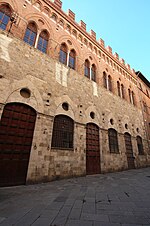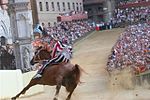San Giuseppe, Siena
1653 establishments in Italy17th-century Roman Catholic church buildings in ItalyBaroque architecture in SienaRenaissance architecture in SienaRoman Catholic churches completed in 1653 ... and 1 more
Roman Catholic churches in Siena

San Giuseppe is a Roman Catholic church in Siena, Tuscany, Italy. The church was commissioned by the contrada dell'Onda and begun in 1521. Construction continued for the whole century. The façade, finished in 1653, is mostly in brickwork, with two superimposed orders divided by pilaster strips. The interior is on the Greek Cross plan, surmounted by an octagonal dome with a lantern. Decoration is attributed to the Nasini family. The crypt, a suggestive 16th century hall, contains the contrada's museum.
Excerpt from the Wikipedia article San Giuseppe, Siena (License: CC BY-SA 3.0, Authors, Images).San Giuseppe, Siena
Via di Fontanella, Siena Ravacciano
Geographical coordinates (GPS) Address Nearby Places Show on map
Geographical coordinates (GPS)
| Latitude | Longitude |
|---|---|
| N 43.315277777778 ° | E 11.331944444444 ° |
Address
Mond - Museo della Contrada Capitana dell'Onda
Via di Fontanella
47065 Siena, Ravacciano
Tuscany, Italy
Open on Google Maps











